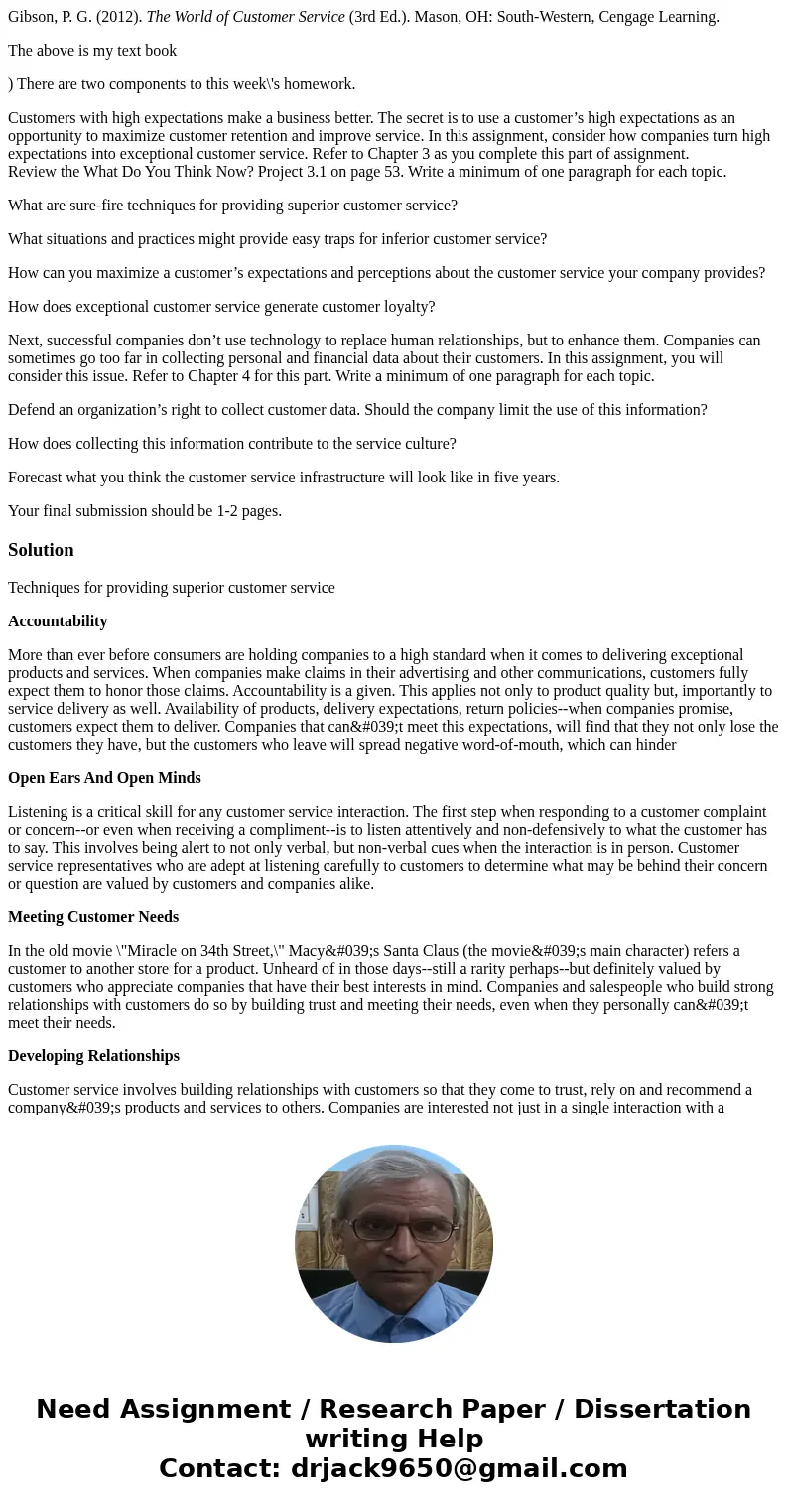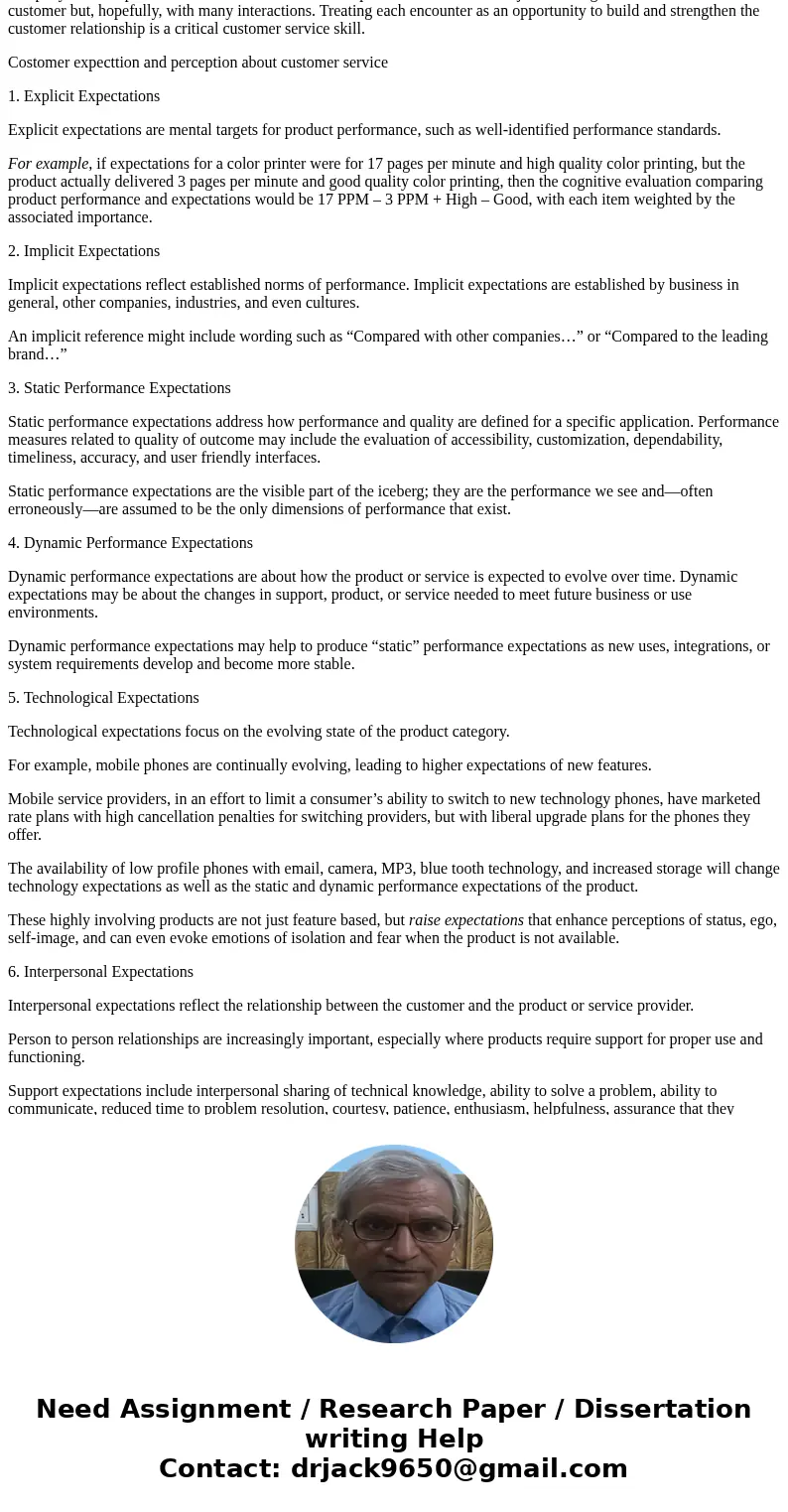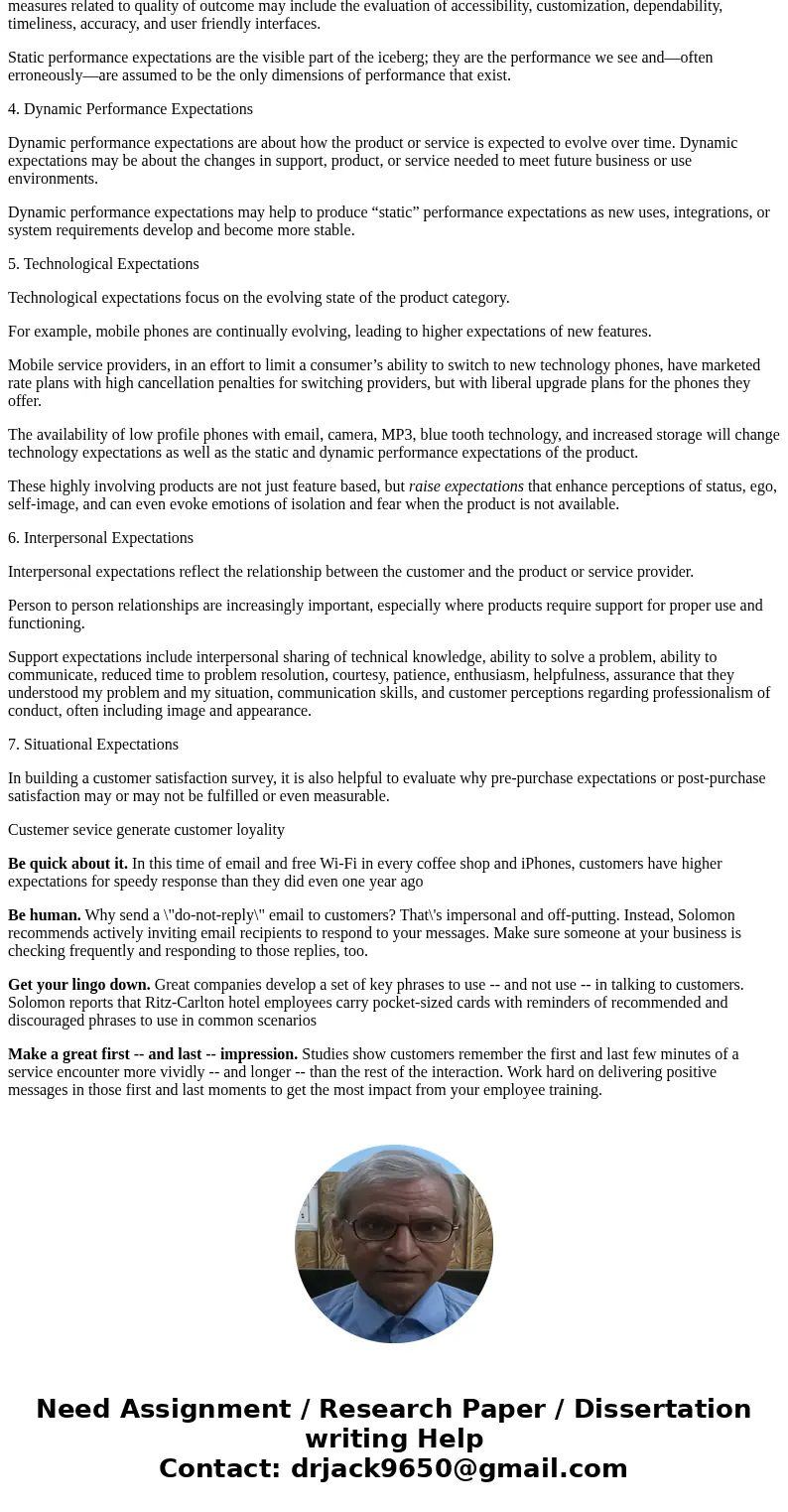Gibson P G 2012 The World of Customer Service 3rd Ed Mason O
Gibson, P. G. (2012). The World of Customer Service (3rd Ed.). Mason, OH: South-Western, Cengage Learning.
The above is my text book
) There are two components to this week\'s homework.
Customers with high expectations make a business better. The secret is to use a customer’s high expectations as an opportunity to maximize customer retention and improve service. In this assignment, consider how companies turn high expectations into exceptional customer service. Refer to Chapter 3 as you complete this part of assignment.
Review the What Do You Think Now? Project 3.1 on page 53. Write a minimum of one paragraph for each topic.
What are sure-fire techniques for providing superior customer service?
What situations and practices might provide easy traps for inferior customer service?
How can you maximize a customer’s expectations and perceptions about the customer service your company provides?
How does exceptional customer service generate customer loyalty?
Next, successful companies don’t use technology to replace human relationships, but to enhance them. Companies can sometimes go too far in collecting personal and financial data about their customers. In this assignment, you will consider this issue. Refer to Chapter 4 for this part. Write a minimum of one paragraph for each topic.
Defend an organization’s right to collect customer data. Should the company limit the use of this information?
How does collecting this information contribute to the service culture?
Forecast what you think the customer service infrastructure will look like in five years.
Your final submission should be 1-2 pages.
Solution
Techniques for providing superior customer service
Accountability
More than ever before consumers are holding companies to a high standard when it comes to delivering exceptional products and services. When companies make claims in their advertising and other communications, customers fully expect them to honor those claims. Accountability is a given. This applies not only to product quality but, importantly to service delivery as well. Availability of products, delivery expectations, return policies--when companies promise, customers expect them to deliver. Companies that can't meet this expectations, will find that they not only lose the customers they have, but the customers who leave will spread negative word-of-mouth, which can hinder
Open Ears And Open Minds
Listening is a critical skill for any customer service interaction. The first step when responding to a customer complaint or concern--or even when receiving a compliment--is to listen attentively and non-defensively to what the customer has to say. This involves being alert to not only verbal, but non-verbal cues when the interaction is in person. Customer service representatives who are adept at listening carefully to customers to determine what may be behind their concern or question are valued by customers and companies alike.
Meeting Customer Needs
In the old movie \"Miracle on 34th Street,\" Macy's Santa Claus (the movie's main character) refers a customer to another store for a product. Unheard of in those days--still a rarity perhaps--but definitely valued by customers who appreciate companies that have their best interests in mind. Companies and salespeople who build strong relationships with customers do so by building trust and meeting their needs, even when they personally can't meet their needs.
Developing Relationships
Customer service involves building relationships with customers so that they come to trust, rely on and recommend a company's products and services to others. Companies are interested not just in a single interaction with a customer but, hopefully, with many interactions. Treating each encounter as an opportunity to build and strengthen the customer relationship is a critical customer service skill.
Costomer expecttion and perception about customer service
1. Explicit Expectations
Explicit expectations are mental targets for product performance, such as well-identified performance standards.
For example, if expectations for a color printer were for 17 pages per minute and high quality color printing, but the product actually delivered 3 pages per minute and good quality color printing, then the cognitive evaluation comparing product performance and expectations would be 17 PPM – 3 PPM + High – Good, with each item weighted by the associated importance.
2. Implicit Expectations
Implicit expectations reflect established norms of performance. Implicit expectations are established by business in general, other companies, industries, and even cultures.
An implicit reference might include wording such as “Compared with other companies…” or “Compared to the leading brand…”
3. Static Performance Expectations
Static performance expectations address how performance and quality are defined for a specific application. Performance measures related to quality of outcome may include the evaluation of accessibility, customization, dependability, timeliness, accuracy, and user friendly interfaces.
Static performance expectations are the visible part of the iceberg; they are the performance we see and—often erroneously—are assumed to be the only dimensions of performance that exist.
4. Dynamic Performance Expectations
Dynamic performance expectations are about how the product or service is expected to evolve over time. Dynamic expectations may be about the changes in support, product, or service needed to meet future business or use environments.
Dynamic performance expectations may help to produce “static” performance expectations as new uses, integrations, or system requirements develop and become more stable.
5. Technological Expectations
Technological expectations focus on the evolving state of the product category.
For example, mobile phones are continually evolving, leading to higher expectations of new features.
Mobile service providers, in an effort to limit a consumer’s ability to switch to new technology phones, have marketed rate plans with high cancellation penalties for switching providers, but with liberal upgrade plans for the phones they offer.
The availability of low profile phones with email, camera, MP3, blue tooth technology, and increased storage will change technology expectations as well as the static and dynamic performance expectations of the product.
These highly involving products are not just feature based, but raise expectations that enhance perceptions of status, ego, self-image, and can even evoke emotions of isolation and fear when the product is not available.
6. Interpersonal Expectations
Interpersonal expectations reflect the relationship between the customer and the product or service provider.
Person to person relationships are increasingly important, especially where products require support for proper use and functioning.
Support expectations include interpersonal sharing of technical knowledge, ability to solve a problem, ability to communicate, reduced time to problem resolution, courtesy, patience, enthusiasm, helpfulness, assurance that they understood my problem and my situation, communication skills, and customer perceptions regarding professionalism of conduct, often including image and appearance.
7. Situational Expectations
In building a customer satisfaction survey, it is also helpful to evaluate why pre-purchase expectations or post-purchase satisfaction may or may not be fulfilled or even measurable.
Custemer sevice generate customer loyality
Be quick about it. In this time of email and free Wi-Fi in every coffee shop and iPhones, customers have higher expectations for speedy response than they did even one year ago
Be human. Why send a \"do-not-reply\" email to customers? That\'s impersonal and off-putting. Instead, Solomon recommends actively inviting email recipients to respond to your messages. Make sure someone at your business is checking frequently and responding to those replies, too.
Get your lingo down. Great companies develop a set of key phrases to use -- and not use -- in talking to customers. Solomon reports that Ritz-Carlton hotel employees carry pocket-sized cards with reminders of recommended and discouraged phrases to use in common scenarios
Make a great first -- and last -- impression. Studies show customers remember the first and last few minutes of a service encounter more vividly -- and longer -- than the rest of the interaction. Work hard on delivering positive messages in those first and last moments to get the most impact from your employee training.



 Homework Sourse
Homework Sourse